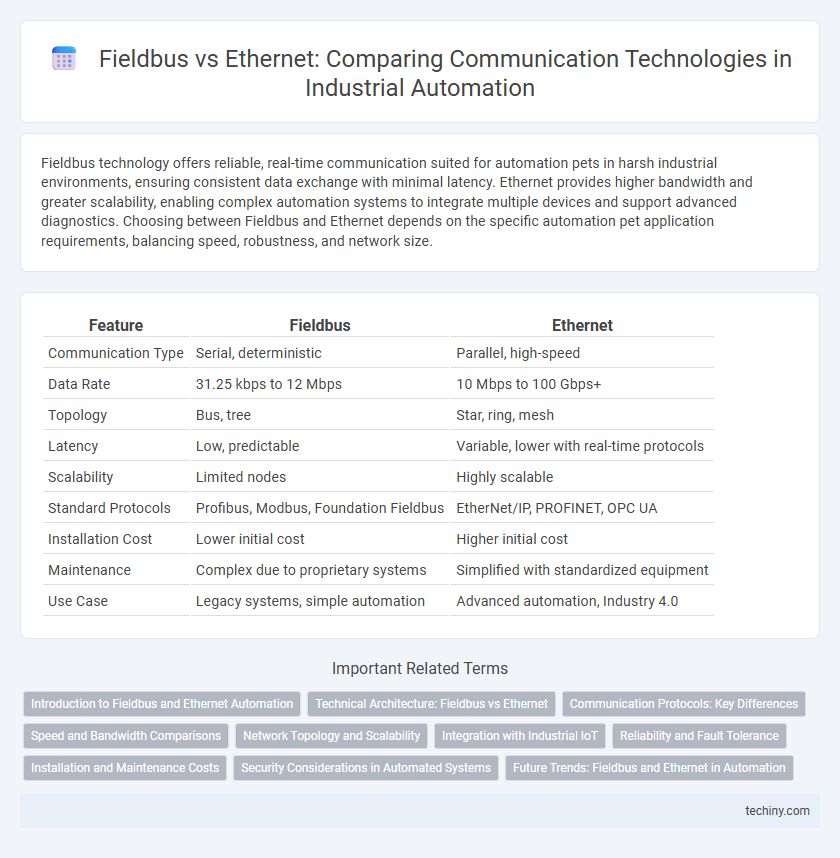Fieldbus technology offers reliable, real-time communication suited for automation pets in harsh industrial environments, ensuring consistent data exchange with minimal latency. Ethernet provides higher bandwidth and greater scalability, enabling complex automation systems to integrate multiple devices and support advanced diagnostics. Choosing between Fieldbus and Ethernet depends on the specific automation pet application requirements, balancing speed, robustness, and network size.
Table of Comparison
| Feature | Fieldbus | Ethernet |
|---|---|---|
| Communication Type | Serial, deterministic | Parallel, high-speed |
| Data Rate | 31.25 kbps to 12 Mbps | 10 Mbps to 100 Gbps+ |
| Topology | Bus, tree | Star, ring, mesh |
| Latency | Low, predictable | Variable, lower with real-time protocols |
| Scalability | Limited nodes | Highly scalable |
| Standard Protocols | Profibus, Modbus, Foundation Fieldbus | EtherNet/IP, PROFINET, OPC UA |
| Installation Cost | Lower initial cost | Higher initial cost |
| Maintenance | Complex due to proprietary systems | Simplified with standardized equipment |
| Use Case | Legacy systems, simple automation | Advanced automation, Industry 4.0 |
Introduction to Fieldbus and Ethernet Automation
Fieldbus automation uses digital, serial communication protocols designed for real-time distributed control in industrial environments, connecting sensors, actuators, and controllers with deterministic timing. Ethernet automation employs standard Ethernet technologies enhanced with protocols like EtherCAT and PROFINET to offer higher bandwidth, flexible network topologies, and seamless integration with IT infrastructure. Both systems enable efficient process automation, with Fieldbus excelling in simplicity and reliability for localized control, while Ethernet supports scalability and data-intensive applications in modern industrial networks.
Technical Architecture: Fieldbus vs Ethernet
Fieldbus utilizes a hierarchical, master-slave architecture with deterministic communication suited for real-time control in industrial automation, supporting a limited number of devices per segment. Ethernet employs a decentralized, peer-to-peer architecture enabling scalable, high-bandwidth connectivity with flexible topologies like star, mesh, or ring, suitable for extensive data exchange and integration with IT networks. Fieldbus protocols such as PROFIBUS and Foundation Fieldbus operate at lower data rates with time-critical synchronization, whereas Industrial Ethernet variants like EtherCAT and PROFINET offer higher speeds and seamless interoperability with standard Ethernet infrastructure.
Communication Protocols: Key Differences
Fieldbus communication protocols operate on a deterministic, cyclic data exchange system tailored for real-time industrial automation, offering lower latency and higher reliability in harsh environments. Ethernet protocols, such as EtherNet/IP and PROFINET, utilize standard TCP/IP stacks enabling high-speed, flexible, and scalable networks with extensive bandwidth for complex data and multimedia transmission. The primary distinction lies in Fieldbus's device-level control optimization versus Ethernet's broader enterprise integration and IT standard compatibility.
Speed and Bandwidth Comparisons
Ethernet networks offer significantly higher speed and bandwidth compared to traditional Fieldbus systems, with Ethernet supporting data rates up to 10 Gbps and beyond, while most Fieldbus protocols typically max out at 31.25 Kbps to 12 Mbps. Ethernet's superior bandwidth enables real-time data transmission and supports complex automation tasks, facilitating faster communication between devices and reducing latency. Fieldbus systems, although reliable for specific industrial applications, cannot match Ethernet's scalability and throughput, making Ethernet the preferred choice for high-speed, data-intensive automation environments.
Network Topology and Scalability
Fieldbus networks typically use a linear or bus topology that limits scalability due to signal degradation and increased wiring complexity as nodes increase. Ethernet networks support star or tree topologies, enabling higher scalability and easier integration of multiple devices without significant performance loss. Ethernet's superior bandwidth and flexible topology make it ideal for expanding automation systems requiring robust, scalable communication infrastructure.
Integration with Industrial IoT
Fieldbus protocols, such as PROFIBUS and FOUNDATION Fieldbus, offer robust real-time control and deterministic communication tailored for traditional automation systems, but they face limitations in scalability and seamless integration with Industrial IoT platforms. Ethernet-based solutions, including Industrial Ethernet standards like PROFINET and EtherNet/IP, provide higher bandwidth, standardized IP connectivity, and enhanced interoperability, facilitating efficient data exchange and integration with cloud-based IoT analytics and remote monitoring. The shift toward Ethernet in industrial environments supports the growing demand for smart manufacturing, predictive maintenance, and edge computing capabilities within Industrial IoT ecosystems.
Reliability and Fault Tolerance
Fieldbus networks provide high reliability and fault tolerance through deterministic communication and redundant wiring, minimizing data loss in harsh industrial environments. Ethernet-based systems, enhanced with protocols like PROFINET and EtherCAT, offer superior speed and scalability while maintaining robustness via advanced error detection and recovery mechanisms. Both technologies ensure reliable automation processes, but Ethernet excels in integrating complex, large-scale operations with flexible fault management.
Installation and Maintenance Costs
Fieldbus systems typically involve higher installation complexity due to specialized wiring and protocol converters, which can increase initial setup costs compared to Ethernet. Ethernet technologies leverage standardized cabling and components, reducing both installation time and labor expenses. Maintenance costs for Fieldbus often escalate with proprietary parts and limited compatibility, whereas Ethernet benefits from widespread adoption, easier diagnostics, and scalable upgrades, lowering long-term expenses.
Security Considerations in Automated Systems
Fieldbus protocols offer simpler, isolated networks with fewer entry points, reducing attack surfaces but often lack advanced encryption and authentication measures. Ethernet-based systems provide robust security features like VLAN segmentation, TLS encryption, and intrusion detection but require complex management to mitigate vulnerabilities inherent in IP-based technologies. Evaluating security in automated systems demands balancing Fieldbus's inherent isolation with Ethernet's advanced protective capabilities tailored to specific industrial requirements.
Future Trends: Fieldbus and Ethernet in Automation
Fieldbus and Ethernet represent key communication protocols in industrial automation, with Ethernet increasingly favored due to higher speeds, scalability, and compatibility with IIoT technologies. Future trends indicate a shift toward Ethernet-based solutions like Time-Sensitive Networking (TSN) to meet real-time control requirements while maintaining deterministic performance. As automation systems evolve, integration of Ethernet with advanced cybersecurity measures and standardized protocols will drive its dominance over traditional Fieldbus networks.
Fieldbus vs Ethernet Infographic

 techiny.com
techiny.com